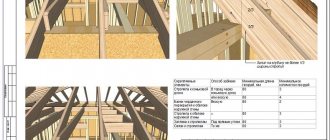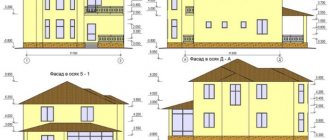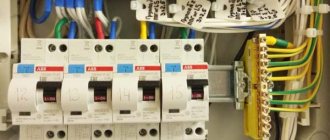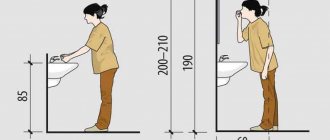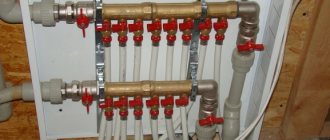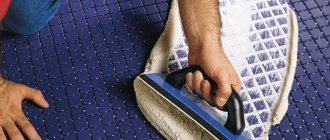The purpose of an RCD has already been discussed several times, and its installation in a modern household electrical network is definitely the most important protection for a person from electric shock. But how to choose an RCD? Based on what parameters? How to calculate a device for a particular protected consumer? Let's try to figure it all out.
To make the right choice of RCD, you need to understand its purpose, main characteristics and parameters. When you buy a device, pay attention to its case, all the important information is indicated there. So that these numbers and letters tell you something, we will analyze each of them separately.
Purpose
The most important thing to understand is that a circuit breaker protects the electrical network from overcurrents, and an RCD provides human protection. If, as a result of an insulation breakdown, potential appears on the body of an electrical appliance, touching it is likely to result in an electric shock. To prevent this from happening, immediately when a current leak occurs, the protective shutdown device will react and turn off the damaged section of the circuit.
It is important to know! RCDs do not protect against overloads and short circuits, so circuit breakers must be connected in series with them in the circuit.
Installing a residual current device yourself
It is not difficult to install current protection. You will need a 3x2.5 mm VVG wire - it is pulled from the switchboard. The procedure is as follows:
- Using the indicator, phase and zero are determined.
- Connect the found conductors to the RCD.
- The wires are removed from the housing and the socket is connected to the RCD.
This is the simplest connection diagram. If, in addition to the washing machine, other consumers will be connected to the network, install an additional protective device. This will ensure uninterrupted operation for all consumers.
The difavtomat is installed in the same way. Thanks to this device, your washing machine will be reliably protected from dangerous power surges that can hopelessly damage any of its components - motor, control unit, pump, etc., and you - from electric shock.
When installing the washing machine in the bathroom, the outlet must be:
- moisture-proof;
- grounded.
If washing is in progress, it is better not to take a bath: if water splashes into the socket, a short circuit may occur and an electric shock may occur. After completing the cycle, remove the plug from the socket and close the lid of the socket tightly. All laid wires are protected with plastic corrugations. The wiring is located as high as possible from the floor. The ideal solution is a separate wire for the washing machine. Its minimum cross-section is 2.5 m². The socket and protective automatic equipment must be located so that in the event of a breakdown, the equipment can be easily switched off.
Trademark
Speaking about the brand, we will essentially analyze the price-quality ratio. The fact is that there is an unspoken classification of all RCD manufacturers according to their territorial location - European models, Asian and Russian.
One way to spot a fake video:
Each of their products has its own characteristic features:
- Both a fire-fighting RCD and a device that protects people from electric shock produced in Europe will cost an order of magnitude more than models from Russia and China. But this price guarantees quality and reliability. It will not be amiss to know that some European companies, in addition to the main high-quality assortment, produce RCDs for the markets of other countries with the same reliability, but with reduced technical characteristics.
- Domestic manufacturers offer RCDs at a lower price than their counterparts from Europe, however, they meet all regulatory requirements of Russian standards. So far, Russian manufacturers' sales network is not so strong, and the devices themselves are not able to compete with Asians in price or with Europe in terms of quality.
- RCDs from Asian manufacturers are in greatest demand in the world. Some manufacturers from Asia enter into contracts with suppliers of products to the Russian market and in this case produce devices under the Russian brand.
Before choosing an RCD brand, decide what means you have for installing automatic protective equipment in an apartment or private house. Most preferred companies:
- Swiss "ABB";
- French Legrand and Schneider Electric;
- German "Siemens" and "Moeller".
Among domestic manufacturers, the most widely used products are:
- Kursky, average price and quality, the company gives a two-year guarantee for the RCDs produced, which indicates the reliability of the products;
- Moscow (“IEC”), products do not always receive positive reviews, however, the demand for it is high due to its low cost;
- Ulyanovsk, it is part of the group, which affects the quality of the products and, accordingly, the price;
- relatively young St. Petersburg, on the Russian market it represents the world-famous company “Schneider Electric”.
As for Chinese manufacturers, the RCDs they produce are a direct competitor to Russian devices. Price and quality are approximately at the same level, while the warranty period for Chinese goods is five years.
Main settings
After the trademark, the main ratings and performance characteristics of the RCD are indicated on the body.
- Model name and series. Please note that here you will not always see the letters RCD; some manufacturers designate this device as a VDT (residual current switch).
- The value of the rated voltage and frequency. In the Russian power system, the operating frequency is 50 Hz. As for voltage, for a single-phase network in an apartment it is 220-230 V. For a private house, a three-phase network is sometimes needed and the operating voltage will be 380 V.
Characteristics of the RCD in the video:
- The rated operating current is the maximum value that the RCD is capable of switching.
- Rated differential current. This is the value at which the device is triggered.
- The temperature limits of the RCD operation are also indicated here (minimum - 25 degrees, maximum + 40).
- Another current value is the rated conditional short-circuit current. This is the maximum short circuit current that the device will withstand and not turn off, but provided that a suitable circuit breaker is installed in series with it.
- Nominal response time. This is the time period from the moment when a current leak suddenly occurs until it must be extinguished by all poles of the RCD. The maximum permissible value is 0.03 s.
- The RCD diagram must be drawn on the housing.
Leakage current shape
According to this parameter, all residual current devices are classified into three types:
- "A". Such a device trips when instantaneously occurring or gradually increasing current leaks have a sinusoidal variable or pulsating constant shape. This is the most common type of RCD. Due to the fact that it controls both alternating and direct current, it is more expensive.
- "AS". Also a common and more affordable device. It only works to generate alternating sinusoidal current leakage.
- "IN". This device is mainly used to protect industrial premises. In addition to the alternating sinusoidal RCD, it responds to the rectified and pulsating form of direct current leakage.
A completely logical question arises: in household networks, alternating current of a sinusoidal shape flows; can it be sufficient to install “AC” type devices everywhere? But if you take a closer look at the characteristics of modern household appliances, most of them have power supplies with electronic semiconductor components, reaching which the sine wave is converted into pulsed half-cycles. And if the leak is not of a sinusoidal nature, then the AC type RCD will not detect it and will not turn off.
That is why in the passports for many household appliances the manufacturer indicates through which RCD the connection must be made.
Tips for choosing an RCD on video:
Why are extension cords banned?
The power wires transmit power of more than 2 kW. Therefore, all disconnecting connections must ensure perfect contact. This is possible with European sockets that have a large area of contacting contacts. But this cannot be done without losses, and extension cords only increase them. The consequence of losses is heating. Extension cords are often plugged into regular sockets - with the help of adapters, losses increase even more. Due to constant heating, contacts burn and plugs and sockets deteriorate. As a result, a fire occurs.
Operating principle
There are electronic and electromechanical RCDs.
The second is more expensive, but does not depend on the power supply. It will work as soon as a current leak occurs in the circuit.
An electronic device in its operation depends on an amplifier built into the electrical circuit. And in order for this amplifier to always be in working condition, it requires an external power source. In this regard, the reliability of operation is reduced.
When choosing an RCD for this parameter, we recommend giving preference to electromechanical devices.
Selectivity
According to the selectivity of operation, residual current devices are of two types - “G” and “S”.
These RCDs are triggered after a certain period of time, called dwell time. They are used when several devices are connected in series. To protect outgoing consumer branches, devices are installed without a time delay, and at the input there are RCDs of type “G” and “S”. If a current leak occurs and the outgoing RCD does not respond, then after a certain time the device at the input should turn off.
For RCDs of type “S” the shutter speed is set in the range from 0.15 to 0.5 s, for type “G” - from 0.06 to 0.08 s.
How to connect a washing machine to the mains?
It’s not enough to buy a washing machine, you also need to connect it correctly. When all pipes are connected, electrical work begins. Installation rules:
- Do not use the washing machine without grounding.
- Do not use extension cords. It is also not recommended to use a special extension cord with an RCD.
- In rooms with a high moisture content, sockets must be installed in a moisture-proof housing.
- Connect the washing machine through a protective device.
Two-level fire protection
For a wooden private house, guaranteeing fire safety is especially important. Therefore, in this situation, it is necessary to select an RCD, planning a two-level differential protection system. Its main purpose is that the protective function is divided:
- fire protection RCD ensures operation in case of large current leaks that contribute to fire;
- ordinary devices will prevent electric shock to a person with small leakage values.
Since the fire protection RCD has a high leakage current rating, it will not provide human protection on its own. Therefore, it is always installed together with an RCD, which has less leakage current.
Regardless of the value of the rated operating current and how many poles a fire protection RCD has, the leakage current parameter of such a device is 100 mA and 300 mA, otherwise it is no different from an ordinary one.
The connection diagram is carried out sequentially, we install a fire protection RCD closer to the power source (at the input), and universal ones on the outgoing branches of the protected wiring.
Visually about the fire protection RCD in the video:
Using an example, it looks something like this: we select the input RCD with parameters 63 A (nominal operating current) and 300 mA (leakage current), the remaining devices, respectively, are 40 A and 30 mA for the socket group, 25 A and 10 mA for the bathroom, 16 A and 10 mA for the lighting group.
The use of fire-fighting devices is also advisable in an apartment. Often the lighting group is left unprotected from leakage currents. With minimal probability, but high current leaks can occur in this branch, and if such an RCD is installed at the input, it will be a kind of safety net.
Operating principle of RCD
To prevent accidental electric shock from contact with household and industrial electrical appliances, a residual current device was invented.
It is based on a transformer with a toroidal core, which monitors the current strength at “phase” and “zero”. If its levels diverge, then the relay is activated and the power contacts are disconnected.
You can check the RCD by pressing the special “TEST” button. As a result, a current leak is simulated, and the device must disconnect the power contacts
Normally, any electrical device has a current leakage. But its level is so low that it is safe for the human body.
Therefore, RCDs are programmed to operate at a current value that can cause electrical injury to people or lead to equipment breakdown.
For example, when a child inserts a bare metal pin into an outlet, electricity will leak through the body, and the RCD will turn off the light in the apartment.
The speed of operation of the device is such that the body will not experience any negative sensations at all.
The RCD adapter is convenient because it allows you to quickly move between sockets. It is suitable for people who do not want to install stationary protective devices
Depending on the power of the connected equipment, the presence of intermediate protective devices and the length of the electrical wiring, RCDs with different limiting values of differential currents are used.
The most common protective devices in everyday life are those with threshold levels of 10 mA, 30 mA and 100 mA. These devices are sufficient to protect most residential and office premises.
It should be remembered that the classic RCD does not protect electrical wiring from short circuits and does not disconnect power contacts when the network is overloaded. Therefore, it is advisable to use these devices in combination with other electrical protection mechanisms, for example, circuit breakers.
Performing calculations
Let's try, using an example, to calculate which RCD still needs to be chosen for a particular protected branch of electrical home wiring.
In practice, it is not always possible to accurately calculate the total leakage current. Therefore, it is approximately determined by the following method: for 1 A of consumed load, take 0.4 mA of current leakage. You should also make a calculation based on the length of the phase wire - 10 μA is taken per 1 m.
Let’s say you need to choose the right RCD according to the power of the electric stove (3 kW). First, we calculate its load: 3000 W / 220 V = 13.64 A. Leakage current for the stove: 13.64 A x 0.4 mA = 5.46 mA. We perform the same calculation for a laid conductor, for example, 10 m: 10 µA x 10 m = 100 µA = 0.1 mA. In total, the leakage current is: 5.46 mA + 0.1 mA = 5.56 mA.
The resulting value of the sum of current leakage should not exceed 33% of the differential rated current of the RCD. And then the calculation from school mathematics lessons, we make an elementary proportion and get: 5.56 mA x 100% / 33% = 16.85 mA.
There is a special table of standard values of rated leakage currents, based on it, a 25 mA device is suitable for an electric stove.
You now know how to choose an RCD for an apartment or house, and you can determine the total calculated leakage current yourself. If you have even the slightest doubt about your knowledge and abilities, invite a professional electrician to do this work. Do not forget that the residual current device is a guarantee of your safety.
Practical advice for installing difavtomats
New houses are equipped with grounded sockets and a panel with protective devices. All that remains is to select an outlet and find out which machine it is connected to. If there is an RCD there, it needs to be dismantled and a circuit breaker installed.
In old houses everything is much more complicated. There is no grounding, there is no automatic protection either. They start with installing the ground loop. Three galvanized pipes are installed near the house or in the basement. Their length is from 50 cm. The pipes are positioned so that they are the vertices of a triangle. If it doesn’t work out, you can do it on one straight line. A wire is screwed to one pipe using a bolt - it is pulled into the apartment, to the panel.
The European socket for the washing machine is connected to the automatic machine installed in the panel specifically for this purpose. The device is selected taking into account the current consumed by the equipment. It is determined based on the rated power. Power, kW, is divided by voltage, V. Then 20% is added - this will be the average current. Take the option with a current equal to the calculated value or slightly greater.

